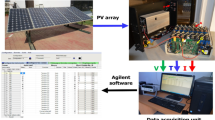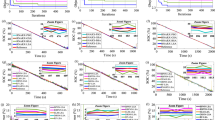Abstract
The demand for energy storage is increasing massively due to the electrification of transport and the expansion of renewable energies. Current battery technologies cannot satisfy this growing demand because they are difficult to recycle, because the necessary raw materials are mined under precarious conditions, and because the energy density is insufficient. Metal-air batteries offer a high energy density because there is only one active mass inside the cell and the cathodic reaction uses the ambient air. Various metals can be used, but zinc is very promising because of its disposability, non-toxic behavior, and because operation as a secondary cell is possible. Typical characteristics of zinc-air batteries are flat charge and discharge curves. On the one hand, this is an advantage for the subsequent power electronics, which can be optimized for smaller and constant voltage ranges. On the other hand, the state determination of the system becomes more complex, since the voltage level is not sufficient to determine the state of the battery. In this context, electrochemical impedance spectroscopy is a promising candidate since the resulting impedance spectra depend on the state of charge, working point, state of aging, and temperature. Therefore, in this publication, electrochemical impedance spectroscopy is combined with multiple machine learning techniques to also determine successfully the state of charge during charging of the cell at non-fixed charging currents.
Funded by organization EFRE-0801585.
Access this chapter
Tax calculation will be finalised at checkout
Purchases are for personal use only
Similar content being viewed by others
References
ADAC: Zufahrtsbeschränkungen in Europa (2021). https://www.adac.de/verkehr/abgas-diesel-fahrverbote/fahrverbote/fahrv/
Barsoukov, E., Macdonald, J.R. (eds.): Impedance spectroscopy: theory, experiment, and applications. Wiley, Hoboken, NJ, third edition edn. (2018)
Boukamp, B.A.: Impedance Spectroscopy, Strength and Limitations (Impedanzspektroskopie, Stärken und Grenzen). tm - Technisches Messen 71, 454–459 (2004). https://doi.org/10.1524/teme.71.9.454.42758
Bundesministerium fuer Wirtschaft and Bundesministerium fuer Bildung und Forschung: Plattform Industrie 4.0 - Was ist Industrie 4.0 (2021). https://www.plattform-i40.de/IP/Navigation/DE/Industrie40/WasIndustrie40/was-ist-industrie-40.html
Chakkaravarthy, C., Waheed, A., Udupa, H.: Zinc-air alkaline batteries - a review. J. Power Sources 6(3), 203–228 (1981)
Dufo-López, R., Cortés-Arcos, T., Artal-Sevil, J.S., Bernal-Agustn, J.L.: Comparison of lead-acid and li-ion batteries lifetime prediction models in stand-alone photovoltaic systems. Appl. Sci. 11(3), 1099 (2021). https://doi.org/10.3390/app11031099. https://www.mdpi.com/2076-3417/11/3/1099
of Energy, U.D.: Energy storage database (2021). https://www.sandia.gov/ess-ssl/global-energy-storage-database/
Huang, J.: Diffusion impedance of electroactive materials, electrolytic solutions and porous electrodes: Warburg impedance and beyond. Electrochimica Acta 281, 170–188 (2018)
Loechte, A., Gebert, O., Gloesekoetter, P.: End of charge detection of batteries with high production tolerances, p. 6. Granada (2019)
Loechte, A., Gebert, O., Gloesekoetter, P.: End of charge detection by processing impedance spectra of batteries. In: Valenzuela, O., Rojas, F., Herrera, L.J., Pomares, H., Rojas, I. (eds.) ITISE 2019. CS, pp. 163–176. Springer, Cham (2020). https://doi.org/10.1007/978-3-030-56219-9_11
Mainar, A.R., et al.: An overview of progress in electrolytes for secondary zinc-air batteries and other storage systems based on Zinc. J. Energy Storage 15, 304–328 (2018)
Melzer, A.: Materialien für Zink und Zink-Luft Batterien (2010). https://docplayer.org/5093744-Materialien-fuer-zink-und-zink-luft-batterien.html
Sun, W., et al.: A rechargeable zinc-air battery based on zinc peroxide chemistry. Science 371(6524), 46–51 (2021). https://doi.org/10.1126/science.abb9554
für Sonnenenergie-und Wasserstoff-Forschung Baden-Württemberg (ZSW): Bestand an Elektro-Pkw weltweit (2021). https://www.zsw-bw.de/mediathek/datenservice.html
Acknowledgement
Funded by EFRE-0801585.
Author information
Authors and Affiliations
Corresponding author
Editor information
Editors and Affiliations
Rights and permissions
Copyright information
© 2023 The Author(s), under exclusive license to Springer Nature Switzerland AG
About this paper
Cite this paper
Loechte, A., Thranow, JO., Winters, F., Heller, A., Gloesekoetter, P. (2023). Comparison of ANN and SVR for State of Charge Regression Evaluating EIS Spectra. In: Rojas, I., Joya, G., Catala, A. (eds) Advances in Computational Intelligence. IWANN 2023. Lecture Notes in Computer Science, vol 14135. Springer, Cham. https://doi.org/10.1007/978-3-031-43078-7_22
Download citation
DOI: https://doi.org/10.1007/978-3-031-43078-7_22
Published:
Publisher Name: Springer, Cham
Print ISBN: 978-3-031-43077-0
Online ISBN: 978-3-031-43078-7
eBook Packages: Computer ScienceComputer Science (R0)




